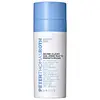What's inside
What's inside
 Key Ingredients
Key Ingredients

 Benefits
Benefits

 Concerns
Concerns

 Ingredients Side-by-side
Ingredients Side-by-side

Salicylic Acid 2%
MaskingWater
Skin ConditioningDimethicone
EmollientPropanediol
SolventCaprylic/Capric Triglyceride
MaskingGlycerin
HumectantJojoba Esters
EmollientIsodecyl Neopentanoate
EmollientCetearyl Alcohol
EmollientPanthenol
Skin ConditioningPolysilicone-11
Cordyceps Sinensis Extract
AntioxidantTrametes Versicolor Extract
Helianthus Annuus Seed Wax
Skin ConditioningSodium Hydroxide
BufferingHydroxyethyl Acrylate/Sodium Acryloyldimethyl Taurate Copolymer
Emulsion StabilisingPolyacrylate Crosspolymer-6
Emulsion StabilisingCeteareth-20
CleansingIsohexadecane
EmollientTocopheryl Acetate
AntioxidantHydrogenated Lecithin
EmulsifyingAloe Barbadensis Leaf Juice
Skin ConditioningButylene Glycol
HumectantAllantoin
Skin ConditioningDisodium EDTA
Sodium Hyaluronate
HumectantAcacia Decurrens Flower Wax
EmollientPolyglycerin-3
HumectantPhenoxyethanol
PreservativePolysorbate 60
EmulsifyingSodium PCA
HumectantSodium Citrate
BufferingSorbitan Isostearate
EmulsifyingMaclura Cochinchinensis Leaf Prenylflavonoids
T-Butyl Alcohol
PerfumingGlycosaminoglycans
EmollientPotassium Sorbate
PreservativeSodium Benzoate
MaskingEthylhexylglycerin
Skin ConditioningCitric Acid
BufferingTrisodium EDTA
Salicylic Acid 2%, Water, Dimethicone, Propanediol, Caprylic/Capric Triglyceride, Glycerin, Jojoba Esters, Isodecyl Neopentanoate, Cetearyl Alcohol, Panthenol, Polysilicone-11, Cordyceps Sinensis Extract, Trametes Versicolor Extract, Helianthus Annuus Seed Wax, Sodium Hydroxide, Hydroxyethyl Acrylate/Sodium Acryloyldimethyl Taurate Copolymer, Polyacrylate Crosspolymer-6, Ceteareth-20, Isohexadecane, Tocopheryl Acetate, Hydrogenated Lecithin, Aloe Barbadensis Leaf Juice, Butylene Glycol, Allantoin, Disodium EDTA, Sodium Hyaluronate, Acacia Decurrens Flower Wax, Polyglycerin-3, Phenoxyethanol, Polysorbate 60, Sodium PCA, Sodium Citrate, Sorbitan Isostearate, Maclura Cochinchinensis Leaf Prenylflavonoids, T-Butyl Alcohol, Glycosaminoglycans, Potassium Sorbate, Sodium Benzoate, Ethylhexylglycerin, Citric Acid, Trisodium EDTA
Salicylic Acid 1%
MaskingEthylhexyl Palmitate
EmollientPPG-14 Butyl Ether
Skin ConditioningHamamelis Virginiana Water
AstringentDimethicone
EmollientAmmonium Acryloyldimethyltaurate/Vp Copolymer
PEG-7 Glyceryl Cocoate
EmulsifyingSilica
AbrasiveSteareth-21
CleansingLavandula Angustifolia Oil
MaskingCitrus Limon Peel Oil
MaskingMentha Viridis Leaf Oil
AstringentGaultheria Procumbens Leaf Oil
MaskingCananga Odorata Flower Oil
MaskingEugenia Caryophyllus Bud Oil
MaskingRosmarinus Officinalis Leaf Oil
MaskingCitral
PerfumingGeraniol
PerfumingEugenol
PerfumingLinalool
PerfumingLimonene
PerfumingBenzyl Benzoate
AntimicrobialEugenia Caryophyllus Flower Extract
AstringentCharcoal Powder
AbrasivePorphyra Yezoensis Extract
Skin ConditioningSucrose
HumectantGlycine
BufferingAlgae Extract
EmollientAvena Sativa Kernel Extract
AbrasiveCaffeine
Skin ConditioningGlucosamine Hcl
Sodium Hyaluronate
HumectantLaminaria Saccharina Extract
Skin ProtectingGlycine Soja Seed
Skin ConditioningButylene Glycol
HumectantSteareth-2
EmulsifyingZinc PCA
HumectantQuaternium-22
Menthol
MaskingAlcohol
AntimicrobialDisodium EDTA
Phenoxyethanol
PreservativeSalicylic Acid 1%, Ethylhexyl Palmitate, PPG-14 Butyl Ether, Hamamelis Virginiana Water, Dimethicone, Ammonium Acryloyldimethyltaurate/Vp Copolymer, PEG-7 Glyceryl Cocoate, Silica, Steareth-21, Lavandula Angustifolia Oil, Citrus Limon Peel Oil, Mentha Viridis Leaf Oil, Gaultheria Procumbens Leaf Oil, Cananga Odorata Flower Oil, Eugenia Caryophyllus Bud Oil, Rosmarinus Officinalis Leaf Oil, Citral, Geraniol, Eugenol, Linalool, Limonene, Benzyl Benzoate, Eugenia Caryophyllus Flower Extract, Charcoal Powder, Porphyra Yezoensis Extract, Sucrose, Glycine, Algae Extract, Avena Sativa Kernel Extract, Caffeine, Glucosamine Hcl, Sodium Hyaluronate, Laminaria Saccharina Extract, Glycine Soja Seed, Butylene Glycol, Steareth-2, Zinc PCA, Quaternium-22, Menthol, Alcohol, Disodium EDTA, Phenoxyethanol
Alternatives
Ingredients Explained
These ingredients are found in both products.
Ingredients higher up in an ingredient list are typically present in a larger amount.
Butylene Glycol (or BG) is used within cosmetic products for a few different reasons:
Overall, Butylene Glycol is a safe and well-rounded ingredient that works well with other ingredients.
Though this ingredient works well with most skin types, some people with sensitive skin may experience a reaction such as allergic rashes, closed comedones, or itchiness.
Learn more about Butylene GlycolDimethicone is a type of synthetic silicone created from natural materials such as quartz.
What it does:
Dimethicone comes in different viscosities:
Depending on the viscosity, dimethicone has different properties.
Ingredients lists don't always show which type is used, so we recommend reaching out to the brand if you have questions about the viscosity.
This ingredient is unlikely to cause irritation because it does not get absorbed into skin. However, people with silicone allergies should be careful about using this ingredient.
Note: Dimethicone may contribute to pilling. This is because it is not oil or water soluble, so pilling may occur when layered with products. When mixed with heavy oils in a formula, the outcome is also quite greasy.
Learn more about DimethiconeDisodium EDTA plays a role in making products more stable by aiding other preservatives.
It is a chelating agent, meaning it neutralizes metal ions that may be found in a product.
Disodium EDTA is a salt of edetic acid and is found to be safe in cosmetic ingredients.
Learn more about Disodium EDTAPhenoxyethanol is a preservative that has germicide, antimicrobial, and aromatic properties. Studies show that phenoxyethanol can prevent microbial growth. By itself, it has a scent that is similar to that of a rose.
It's often used in formulations along with Caprylyl Glycol to preserve the shelf life of products.
Salicylic Acid (also known as beta hydroxy acid or BHA) is a well-known ingredient for treating skin that struggles with acne and clogged pores. It exfoliates both the skin's surface and deep within the pores to help clear out buildup, control oil, and reduce inflammation.
Unlike AHAs (alpha hydroxy acids), salicylic acid is oil-soluble. This allows it to penetrate into pores which makes it especially effective for treating blackheads and preventing future breakouts.
Salicylic acid is also known for its soothing properties. It has a similar structure to aspirin and can calm inflamed or irritated skin, making it a good option for acne-prone skin that is also sensitive.
Concentrations of 0.5-2% are recognized by the U.S. FDA as an over-the-counter topical acne product.
It can cause irritation and/or dryness if one's skin already has a compromised moisture barrier, so it's best to focus on repairing that before introducing this ingredient into your routine.
While salicylic acid does not increase sun sensitivity, it’s still important to wear sunscreen daily to protect your skin.
If you are looking for the ingredient called BHA or Butylated Hydroxyanisole, click here.
Learn more about Salicylic AcidSodium Hyaluronate is hyaluronic acid's salt form. It is commonly derived from the sodium salt of hyaluronic acid.
Like hyaluronic acid, it is great at holding water and acts as a humectant. This makes it a great skin hydrating ingredient.
Sodium Hyaluronate is naturally occurring in our bodies and is mostly found in eye fluid and joints.
These are some other common types of Hyaluronic Acid:
Learn more about Sodium Hyaluronate